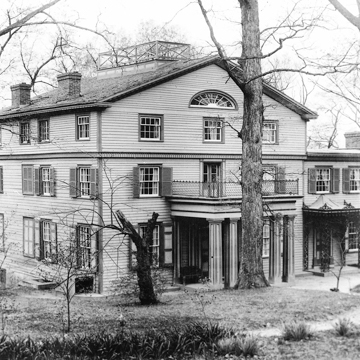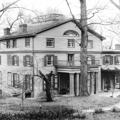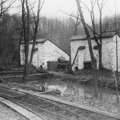Long a scene of bustling enterprise and the occasional disastrous explosion, Hagley Yard has been silent since 1921. Following closure, the grounds were divided up as du Pont family holdings and attractively landscaped, and all but two of the thirty iron rolling-mill wheels (seven tons each) were scrapped in 1942 for the war effort. The subsequent creation of an interpretive museum at Hagley involved some of the first industrial archaeology in the United States, building on the example of Saugus Iron Works, Massachusetts. An essay and photo-pictorial by photographer Walker Evans appeared in Fortune (May 1957).
Today's visitor enters Hagley Yard through the Centennial Gates, beside the New Machine Shop (1902–1903, Black Powder Operating Department). Henry Clay Mill (CH15.2) lies beyond. Two huge bald-cypress trees near Eagle Mill are all that recall the original, eighteenth-century “Hagley” house of Rumford Dawes (demolished early 1930s), who named it after the estate where he was born in England. (A later “Hagley” uphill is illustrated at right) The centrally located Millwright Shop (1858, enlarged 1871) appears in a number of nineteenth-century photographs. The modernist Black Powder Exhibit inside (1961–1962) features working models of many building types in the yard, including several no longer extant.
At the upper end of Hagley Yard stands Birkenhead Mills (1822–1824), oldest of all. In typical powder mill design, the stone walls are massively thick and buttressed against explosions, but open on the side facing the creek and with a flimsy shed roof designed to disintegrate in a blast—aiming the fiery concussion away from the yards. At the Birkenhead, E. I. du Pont first used cast-iron wheels to mix powder ingredients in a rolling mill, a means more efficient than the old stamping process. Massachusetts archaeologist and Saugus veteran Roland Wells Robbins undertook archaeology here in 1955, and the big breast wheel was re-created in 1964. The water level at the dam nearby is thirty-three feet higher than at the one downstream, this fall-of-water once powering the entire yard with its thirty-three mills.









